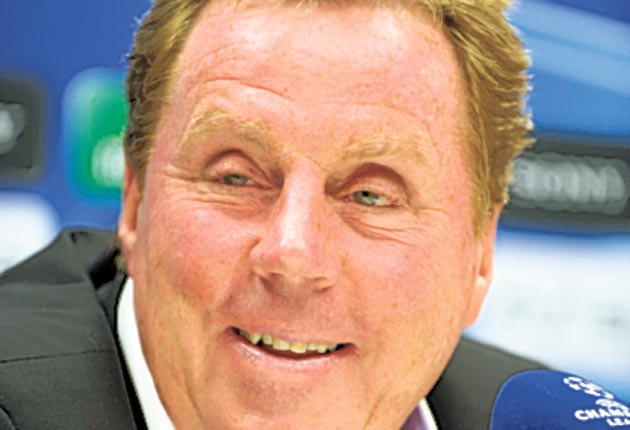Your support helps us to tell the story
From reproductive rights to climate change to Big Tech, The Independent is on the ground when the story is developing. Whether it's investigating the financials of Elon Musk's pro-Trump PAC or producing our latest documentary, 'The A Word', which shines a light on the American women fighting for reproductive rights, we know how important it is to parse out the facts from the messaging.
At such a critical moment in US history, we need reporters on the ground. Your donation allows us to keep sending journalists to speak to both sides of the story.
The Independent is trusted by Americans across the entire political spectrum. And unlike many other quality news outlets, we choose not to lock Americans out of our reporting and analysis with paywalls. We believe quality journalism should be available to everyone, paid for by those who can afford it.
Your support makes all the difference.Three months ago Harry Redknapp was a disappointed man. Joe Cole, a talent he had nurtured as a teenager at West Ham more than a decade ago, had snubbed his Tottenham side as it prepared for a Champions League debut.
Instead the free agent, having been released by Chelsea, opted to join Liverpool, the competition's winners in 2005 and beaten finalists two seasons later.
Fast forward to tomorrow afternoon when Cole will be looking to pull on the famous red shirt for the first time in almost a month, having been sidelined by a hamstring injury. And if he is indeed to make his comeback at White Hart Lane, the 28-year-old England midfielder could be forgiven for wondering what might have been.
Tottenham have thrived in the meantime, not least because on deadline day Redknapp brought in Rafael van der Vaart, a World Cup finalist with the Netherlands over the summer, to fill the roving playmaker role that would have been Cole's.
Internazionale, Werder Bremen and FC Twente had all been put to the sword in the Champions League while Liverpool were clambering painfully up the Premier League table under a new manager in Roy Hodgson and new American owners – clambering all the way from the relegation places up to their current position of ninth, in fact.
"Maybe he felt he needed a change." Redknapp said. "Tottenham are a great club but Liverpool have been up there for years and he probably fancied it. It was a move in the end where the easy option was to stay in London, but he went for it.
"Maybe Joe just fancied moving out of London. Maybe he wanted to go and be completely focused on his football. Joe could have come here and been fantastic for us. You never know but no, we wouldn't have taken Rafa had we taken Joe. And Rafa has been great for us."
Maybe, and then again maybe not, as Redknapp went on to admit. Liverpool put a highly tempting financial package on the table and Tottenham were either slow or just plain reluctant to match it.
"It went out of my hands a bit," he explained. "I could only talk to Joe but it was up to the club to do a deal with him and his agent. It dragged on and in the end Liverpool came in. It probably surprised everybody that he would go up north. I think everybody thought: 'There's only us in London, we're going to get him'.
"I'm not sure what happened in the end. Joe eventually rung me up and said 'Look, sorry, but I'm going to Liverpool'."
Cole is not the only member of the Liverpool squad who could have been turning out for the home side had events panned out slightly differently. The right-back Glen Johnson, who had also been nurtured as a teenager by Redknapp at West Ham, had been in line for a move to White Hart Lane in 2007.
Yet on that particular occasion, it was Redknapp who came out on top, at the expense of his future employer, the Tottenham chairman Daniel Levy.
"Daniel rang me when I was at Portsmouth," Redknapp said. "He said 'What about Glen Johnson, Harry? We're interested in him. Do you think he would be a good signing for Tottenham?'
"I said 'No, no, he's not for Tottenham. He's not good enough for you, Daniel.' And I signed him the next day for Portsmouth.
"Daniel does remind me of that quite often – but that's life, that's football."
Red or White? Building the future
The differing fortunes of Spurs and Liverpool's league form mirrors the clubs' respective stadium situations.
*Spurs' attempts to break into English football's elite have been evident in their determination to secure a new stadium. The Mayor of London, Boris Johnson, this week granted the club permission to begin work on a 56,000-capacity ground, as part of a £450m Northumberland Development Project, to be located at White Hart Lane. The club also retain an interest in moving to the Olympic Stadium in Stratford, with the cost of switching to East London considerably less than redeveloping White Hart, even if they – as has been reported – knock down the Olympic stadium and rebuild it.
*Liverpool, in contrast, have experienced long-term problems in their plans to relocate. In 2002 the club announced plans to build a 55,000-seat stadium in Stanley Park, before subsequent ownership changes and the rejection of a groundshare with Everton delayed developments.
Construction was set to begin in 2007, before a redesign was ordered by then owners George Gillett and Tom Hicks. Chief Executive Officer Rick Parry then said construction on the £400m project would be further delayed owing to the economic downturn. Following John W Henry's takeover a renovation of Anfield has reappeared as an option, as with Henry's redevelopment of Boston Red Sox's stadium, although the local council remain keen on Stanley Park.

Join our commenting forum
Join thought-provoking conversations, follow other Independent readers and see their replies
Comments